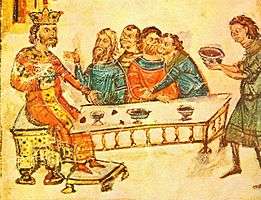811
| Millennium: | 1st millennium |
|---|---|
| Centuries: | |
| Decades: | |
| Years: |
| 811 by topic |
|---|
| Leaders |
| Categories |
|
| Gregorian calendar | 811 DCCCXI |
| Ab urbe condita | 1564 |
| Armenian calendar | 260 ԹՎ ՄԿ |
| Assyrian calendar | 5561 |
| Balinese saka calendar | 732–733 |
| Bengali calendar | 218 |
| Berber calendar | 1761 |
| Buddhist calendar | 1355 |
| Burmese calendar | 173 |
| Byzantine calendar | 6319–6320 |
| Chinese calendar | 庚寅年 (Metal Tiger) 3507 or 3447 — to — 辛卯年 (Metal Rabbit) 3508 or 3448 |
| Coptic calendar | 527–528 |
| Discordian calendar | 1977 |
| Ethiopian calendar | 803–804 |
| Hebrew calendar | 4571–4572 |
| Hindu calendars | |
| - Vikram Samvat | 867–868 |
| - Shaka Samvat | 732–733 |
| - Kali Yuga | 3911–3912 |
| Holocene calendar | 10811 |
| Iranian calendar | 189–190 |
| Islamic calendar | 195–196 |
| Japanese calendar | Kōnin 2 (弘仁2年) |
| Javanese calendar | 707–708 |
| Julian calendar | 811 DCCCXI |
| Korean calendar | 3144 |
| Minguo calendar | 1101 before ROC 民前1101年 |
| Nanakshahi calendar | −657 |
| Seleucid era | 1122/1123 AG |
| Thai solar calendar | 1353–1354 |
| Tibetan calendar | 阳金虎年 (male Iron-Tiger) 937 or 556 or −216 — to — 阴金兔年 (female Iron-Rabbit) 938 or 557 or −215 |
| Wikimedia Commons has media related to 811. |

Battle of Vărbitsa Pass near Pliska (811)

Krum feasts his victory over Nikephoros I
Year 811 (DCCCXI) was a common year starting on Wednesday (link will display the full calendar) of the Julian calendar.
Events
By place
Byzantine Empire
- Byzantine–Bulgarian War: Emperor Nikephoros I organises a new campaign against the Bulgarian Empire, gathering a expeditionary force (around 80,000 men) from all parts of the empire. He is accompanied by high-ranking officials and aristocrats, including his son Stauracius and brother-in-law Michael I Rangabe[1] (both emperors later, for a while). Krum, ruler (khan) of Bulgaria, sends envoys to sue for peace. Nikephoros refuses to accept the terms and marches through the Balkan passes towards Pliska, the Bulgarian capital.
- July 23 – Nikephoros I reaches Pliska, and destroys a Bulgarian army of 12,000 elite soldiers who guard the stronghold. Another hastily assembled relief force of 50,000 soldiers has a similar fate.[2] The Byzantines capture the defenseless capital. Nikephoros plunders the city and captures Krum's treasury.[3] He burns the countryside, slaughters sheep and pigs, as he pursues the retreating Bulgars south-west towards Serdica (modern-day Sofia).[4]
- July 26 – Battle of Vărbitsa Pass: Nikephoros I is trapped (probably in the Vărbitsa Pass) and defeated by the Bulgars, who use the tactics of ambush and surprise night attacks to immobilize the Byzantine forces. Nikephoros himself is killed; Krum has the emperor's head carried back in triumph on a pole, where it is cleaned out, lined with silver and made into a jeweled skull cup, which he allows his Slavic princes (archons) to drink from with him.[5]
- Stauracius is installed as emperor at Adrianople (first time a Byzantine emperor is crowned outside Constantinople). Because of a sword wound near his neck (during the Battle of Pliska), Stauracius is paralyzed. The imperial court is split between the noble factions of his wife Theophano and his sister Prokopia.[6]
- October 2 – Michael I is declared emperor of the Byzantine Empire; Stauracius is forced by senior officials to retire to a monastery.[7]
Europe
- Treaty of Heiligen: King Hemming of Denmark concludes a peace treaty with Emperor Charlemagne in present-day Rendsburg. The southern boundary of Denmark is established at the Eider River.
Abbasid Caliphate
- Fourth Fitna: Abbasid caliph al-Amin appoints Ali ibn Isa ibn Mahan as governor of Khurasan, in northeast Persia, and sends him with an army of 40,000 men against his half-brother al-Ma'mun. Ibn Mahan's army is defeated by a smaller army under Tahir ibn Husayn, at Rayy. During the fighthing Ali ibn Isa ibn Mahan is killed.
Births
- Abu Hatim al-Razi, Muslim hadith scholar (d. 890)
- Basil I, emperor of the Byzantine Empire (d. 886)
- Muhammad al-Jawad, ninth Twelver Shī'ah Imām (d. 835)
- Ōe no Otondo, Japanese scholar (d. 877)
Deaths
- June 17 – Sakanoue no Tamuramaro, Japanese shogun (b. 758)
- July 24 – Gao Ying, chancellor of the Tang Dynasty (b. 740)
- July 26 – Nikephoros I, emperor of the Byzantine Empire
- Ali ibn Isa ibn Mahan, Muslim military leader
- Charles the Younger, son of Charlemagne
- Li Fan, chancellor of the Tang Dynasty (b. 754)
- Pei Ji, chancellor of the Tang Dynasty
- Pepin the Hunchback, son of Charlemagne
References
- ↑ Anonymus Vaticanus, p. 148.
- ↑ Anonymus Vaticanus, pp. 148-149.
- ↑ Anastasius Bibliothecarius. Chronographia tripertita, p. 329.
- ↑ Anonymus Vaticanus, p. 150.
- ↑ John V.A. Fine, Jr. (1991). The early Medieval Balkans: A Critical Survey from the Sixth to the Late Twelfth Century, p. 97. ISBN 978-0-472-08149-3.
- ↑ Treadgold, p. 429; Bury, p. 17.
- ↑ Treadgold, p. 429; Finlay, p. 128.
This article is issued from
Wikipedia.
The text is licensed under Creative Commons - Attribution - Sharealike.
Additional terms may apply for the media files.